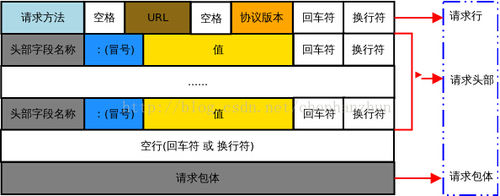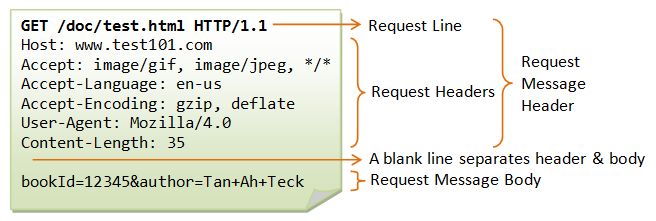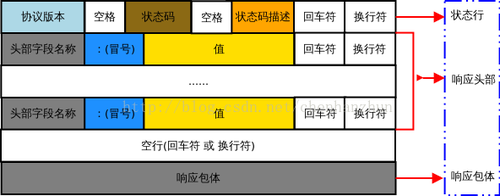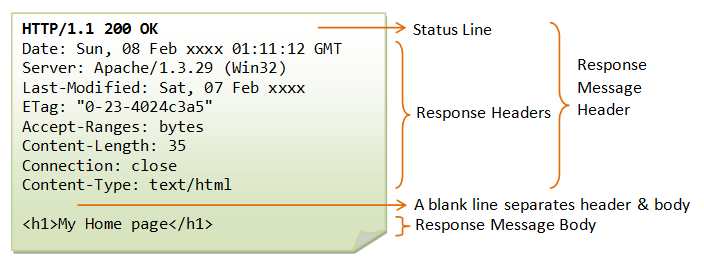TinyHTTPd源码剖析
来源:互联网 发布:如何开网络棋牌室赚钱 编辑:程序博客网 时间:2024/05/16 06:40
TinyHTTPd是一个超轻量型Http Server,使用C语言开发,全部代码只有502行(包括注释),附带一个简单的Client,可以通过阅读这段代码理解一个Http Server 的本质。
文中只给出了几个重要函数的注释,完整的注释代码请看我的github,代码经过我的修改,能够无Warning在Linux下编译通过,同时更改了代码风格。
阅读源代码之前应该了解基本的http知识:
http基础
http报文格式
http报文分为请求报文和响应报文。
http请求报文的格式如下:

例如下面便是一个请求报文的示例:

响应报文的格式如下:

下面是一个响应报文的例子:

在介绍完http报文格式之后,我们提前解析一下源代码中的get_line函数:
get_line函数
每一行都以回车符(carriage return, ‘\r’)和换行符(line feed, ‘\n’)结尾,但应用程序也应该接受单个换行符作为行的终止。这样就可以理解get_line函数的实现了,get_line函数每次读取一行。
/**********************************************************************//* Get a line from a socket, whether the line ends in a newline, * carriage return, or a CRLF combination. Terminates the string read * with a null character. If no newline indicator is found before the * end of the buffer, the string is terminated with a null. If any of * the above three line terminators is read, the last character of the * string will be a linefeed and the string will be terminated with a * null character. * Parameters: the socket descriptor * the buffer to save the data in * the size of the buffer * Returns: the number of bytes stored (excluding null) */ /* 从socket中读取一行内容,换行符可以为'\r', '\n'或'\r\n'. 如果读取到上述三 * 个之一,统一设定为'\n',最后用null字符结尾. 如果没有检测到换行符, * 字符串以null结尾 */ /**********************************************************************/int get_line(int sock, char *buf, int size){ int i = 0; char c = '\0'; int n; while ((i < size - 1) && (c != '\n')) { n = recv(sock, &c, 1, 0); /* DEBUG printf("%02X\n", c); */ if (n > 0) { // 如果末尾是\r或\r\n组合,设为\n if (c == '\r') { // MSG_PEEK选项使得下一次依然可以读取这个字符 n = recv(sock, &c, 1, MSG_PEEK); /* DEBUG printf("%02X\n", c); */ if ((n > 0) && (c == '\n')) recv(sock, &c, 1, 0); else c = '\n'; } buf[i] = c; i++; } else { // 如果没有可读的,将c设置为\n以终止循环 c = '\n'; } } buf[i] = '\0'; return i;}http方法(method)
方法是客户端希望服务器对资源执行的动作,是请求报文第一行的第一个单词。常见的方法有GET、HEAD或POST。tinyhttpd只实现了GET和POST方法。GET通常用于从指定的资源请求数据,POST用于向指定的资源提交要被处理的数据。
介绍完http之后,进入本文的正题,源码剖析:
tinyhttpd中的函数
tinyhttpd主要函数如下:
void accept_request(int);void bad_request(int);void cat(int, FILE *);void cannot_execute(int);void error_die(const char *);void execute_cgi(int, const char *, const char *, const char *);int get_line(int, char *, int);void headers(int, const char *);void not_found(int);void serve_file(int, const char *);int startup(u_short *);void unimplemented(int);其中,bad_request, cannot_execute, error_die, headers, not_found, unimplemented几个函数直接给客户端发送HTML语句,本文就不给出注释了。下面剖析几个重要函数:main, startup, accept_request, execute_gui, get_line, server_file。
下面从main函数开始,一步步分析它的工作原理。
main函数
在main函数中,首先调用startup函数创建一个监听套接字,然后进入一个无限循环,等待客户端请求,一旦有请求,accept函数返回一个已连接套接字,然后调用aceept_request函数处理请求。完成之后,关闭监听套接字。
int main(void){ int server_sock = -1; u_short port = 0; int client_sock = -1; struct sockaddr_in client_name; socklen_t client_name_len = sizeof(client_name); server_sock = startup(&port); // 建立一个监听套接字 printf("httpd running on port %d\n", port); while (1) { // 返回一个已连接套接字 client_sock = accept(server_sock, (struct sockaddr *)&client_name, &client_name_len); if (client_sock == -1) error_die("accept"); accept_request(client_sock); // 处理请求 } close(server_sock); return 0;}startup函数
startup函数按照建立TCP连接的正常流程依次调用socket, bind, listen函数。监听套接字端口既可以指定也可以动态分配一个随机端口。
/**********************************************************************//* This function starts the process of listening for web connections * on a specified port. If the port is 0, then dynamically allocate a * port and modify the original port variable to reflect the actual * port. * Parameters: pointer to variable containing the port to connect on * Returns: the socket */ // 创建一个监听套接字,等待客户的请求/**********************************************************************/int startup(u_short *port){ int httpd = 0; struct sockaddr_in name; httpd = socket(PF_INET, SOCK_STREAM, 0); if (httpd == -1) error_die("socket"); memset(&name, 0, sizeof(name)); name.sin_family = AF_INET; name.sin_port = htons(*port); name.sin_addr.s_addr = htonl(INADDR_ANY); // INADDR_ANY: 表示任意地址, see IP(7) if (bind(httpd, (struct sockaddr *)&name, sizeof(name)) < 0) error_die("bind"); /* if dynamically allocating a port */ if (*port == 0) { socklen_t namelen = sizeof(name); if (getsockname(httpd, (struct sockaddr *)&name, &namelen) == -1) error_die("getsockname"); *port = ntohs(name.sin_port); } if (listen(httpd, 5) < 0) // queue size if 5 error_die("listen"); return httpd;}accept_request函数
accept_request函数首先处理客户端的http请求报文,从中提取信息。accept_request函数首先从第一行——请求行中提取method。在上面的例子中,method数组的内容为字符串"GET",url数组的初始内容为字符串"/test/demo_form.asp?name1=value1&name2=value2",由于其中包含问号(?),是一个动态请求,url经过处理后成为"/test/demo_form.asp",query_string指向问号后面的内容"name1=value1&name2=value2"。
字符串解析完毕之后,可以判断是否是动态请求,如果是则调用execute_cgi函数运行一个cgi脚本,如果是静态请求则调用serve_file函数直接将本地文件发送给客户端。
/**********************************************************************//* A request has caused a call to accept() on the server port to * return. Process the request appropriately. * Parameters: the socket connected to the client */ // 处理请求/**********************************************************************/void accept_request(int client){ char buf[1024]; int numchars; char method[255]; char url[255]; char path[512]; size_t i, j; struct stat st; int cgi = 0; /* becomes true if server decides this is a CGI * program */ char *query_string = NULL; // 获取请求报文的第一行,即为请求行 numchars = get_line(client, buf, sizeof(buf)); i = 0; j = 0; // 获取第一个单词 即为method,常见的method有GET,POST,HEAD等 while (!ISspace(buf[j]) && (i < sizeof(method) - 1)) { method[i] = buf[j]; i++; j++; } method[i] = '\0'; // 只能处理GET和POST method,否则通知客户端请求的操作非法 if (strcasecmp(method, "GET") && strcasecmp(method, "POST")) { unimplemented(client); return; } if (strcasecmp(method, "POST") == 0) cgi = 1; // 获取url i = 0; while (ISspace(buf[j]) && (j < sizeof(buf))) j++; while (!ISspace(buf[j]) && (i < sizeof(url) - 1) && (j < sizeof(buf))) { url[i] = buf[j]; i++; j++; } url[i] = '\0'; // GET请求,如果有问号,则将query_string指向'?'后的内容 // 没有问号,则query_string为NULL if (strcasecmp(method, "GET") == 0) { query_string = url; while ((*query_string != '?') && (*query_string != '\0')) query_string++; // 有问号,则为动态请求 if (*query_string == '?') { cgi = 1; *query_string = '\0'; query_string++; } } sprintf(path, "htdocs%s", url); // 内容存储在htdocs目录下 if (path[strlen(path) - 1] == '/') // '/'代表默认的home page strcat(path, "index.html"); // 如果stat返回错误,回复客户端not_found if (stat(path, &st) == -1) { // 读取并丢弃 headers,第一行请求行之后便是请求头部 while ((numchars > 0) && strcmp("\n", buf)) numchars = get_line(client, buf, sizeof(buf)); not_found(client); } else { // 如果是目录,请求其默认的home page if ((st.st_mode & S_IFMT) == S_IFDIR) strcat(path, "/index.html"); // 如果owner group other任何一个有执行权限 if ((st.st_mode & S_IXUSR) || (st.st_mode & S_IXGRP) || (st.st_mode & S_IXOTH) ) { cgi = 1; } if (!cgi) serve_file(client, path); // 静态请求,直接从硬盘读取文件发送出去 else execute_cgi(client, path, method, query_string); // 动态请求,执行cgi脚本 } close(client);}execute_cgi函数
这是源代码中非常重要的一个函数,处理动态请求。首先判断是GET还是POST,如果是GET则读取header并丢弃,如果是POST,则一直读取header直到遇到Content-Length,解析出长度并保存到content_length变量中。
随后向客户端发送响应报文的第一行——状态行。
接下来,父进程创建两个管道,之后fork一个子进程,子进程设置环境变量之后,调用execl函数运行cgi脚本处理数据,并通过管道和重定向将数据发送给父进程,具体的数据流向请看代码中的注释图。
/**********************************************************************//* Execute a CGI script. Will need to set environment variables as * appropriate. * Parameters: client socket descriptor * path to the CGI script */ // 运行一个 CGI 脚本. 需要设置环境变量/**********************************************************************/void execute_cgi(int client, const char *path, const char *method, const char *query_string){ char buf[1024]; int cgi_output[2]; int cgi_input[2]; pid_t pid; int status; int i; char c; int numchars = 1; int content_length = -1; buf[0] = 'A'; buf[1] = '\0'; if (strcasecmp(method, "GET") == 0) { // 读取并丢弃 headers while ((numchars > 0) && strcmp("\n", buf)) numchars = get_line(client, buf, sizeof(buf)); } else { /* POST */ numchars = get_line(client, buf, sizeof(buf)); // 读取headers // 一行行地读取,直到遇到content_length while ((numchars > 0) && strcmp("\n", buf)) { buf[15] = '\0'; if (strcasecmp(buf, "Content-Length:") == 0) content_length = atoi(&(buf[16])); numchars = get_line(client, buf, sizeof(buf)); } if (content_length == -1) { bad_request(client); return; } } sprintf(buf, "HTTP/1.0 200 OK\r\n"); send(client, buf, strlen(buf), 0); // 关键的部分:父进程和子进程通过管道通信 // 子进程父进程管道流向图 P表示parent, C表示child /* send to brower data <<<---- ---------<--<--<----------- -----<<< \ | | / \ | | / (P) fd 1 (C) fd 0 (C) (P) | | | | ^ v ^ v ^ v ^ v | | | | cgi_output [0] [1] cgi_input [0] [1] | | | | |---<---| |---<---| pipe pipe */ // 建立管道 if (pipe(cgi_output) < 0) { cannot_execute(client); return; } if (pipe(cgi_input) < 0) { cannot_execute(client); return; } if ( (pid = fork()) < 0 ) { cannot_execute(client); return; } // 子进程中执行cgi脚本,cgi脚本将相关内容打印到标准输出 if (pid == 0) { /* 子进程中: CGI script */ char meth_env[255]; char query_env[255]; char length_env[255]; dup2(cgi_output[1], 1); // 将cgi_output的写入端重定向到标准输出 dup2(cgi_input[0], 0); // 将cgi_input的写入端重定向到标准输入 close(cgi_output[0]); // 在子进程中关闭cgi_output的读取端 close(cgi_input[1]); // 在子进程中关闭cgi_input的写入端 sprintf(meth_env, "REQUEST_METHOD=%s", method); putenv(meth_env); if (strcasecmp(method, "GET") == 0) { // 设定query_string环境变量 sprintf(query_env, "QUERY_STRING=%s", query_string); putenv(query_env); } else { /* POST method */ // 设定query_string环境变量 sprintf(length_env, "CONTENT_LENGTH=%d", content_length); putenv(length_env); } // 执行cgi脚本,cgi脚本输出到child的标准输出,通过管道,最终到达了父进程 // 父进程会将其发送给客户端,见下面116, 117行的send execl(path, path, NULL); exit(0); } else { /* in parent */ // 父进程将处理后的请求通过管道发送给子进程 close(cgi_output[1]); // 在父进程中关闭cgi_output的写入端 close(cgi_input[0]); // 在父进程中关闭cgi_output的写入端 // 接收POST过来的数据 if (strcasecmp(method, "POST") == 0) { for (i = 0; i < content_length; i++) { // 从客户端读取一个个字符,最后通过管道重定向到child的标准输入 // 经过上述的管道,最终发送回给客户端 recv(client, &c, 1, 0); write(cgi_input[1], &c, 1); } } // 将从管道中读取的内容发送到client while (read(cgi_output[0], &c, 1) > 0) send(client, &c, 1, 0); // 关闭两个管道的另外一端 close(cgi_output[0]); close(cgi_input[1]); waitpid(pid, &status, 0); }}serve_file函数
如果是静态请求,直接调用serve函数将本地文件发送过去:
/**********************************************************************//* Send a regular file to the client. Use headers, and report * errors to client if they occur. * Parameters: a pointer to a file structure produced from the socket * file descriptor * the name of the file to serve */ // 将文件传送给client/**********************************************************************/void serve_file(int client, const char *filename){ FILE *resource = NULL; int numchars = 1; char buf[1024]; buf[0] = 'A'; buf[1] = '\0'; while ((numchars > 0) && strcmp("\n", buf)) /* read & discard headers */ numchars = get_line(client, buf, sizeof(buf)); resource = fopen(filename, "r"); if (resource == NULL) not_found(client); else { // 将 header 和文件内容传送给 client headers(client, filename); cat(client, resource); } fclose(resource);}/**********************************************************************//* Put the entire contents of a file out on a socket. This function * is named after the UNIX "cat" command, because it might have been * easier just to do something like pipe, fork, and exec("cat"). * Parameters: the client socket descriptor * FILE pointer for the file to cat */ // 将文件的整个内容发送到一个socket上 (静态请求)/**********************************************************************/void cat(int client, FILE *resource){ char buf[1024]; fgets(buf, sizeof(buf), resource); while (!feof(resource)) { send(client, buf, strlen(buf), 0); fgets(buf, sizeof(buf), resource); }}后续
接下来的博文里会介绍如何使用webbench测试TinyHTTPd的性能。
- TinyHTTPd源码剖析
- Tinyhttpd源码剖析(一)
- Tinyhttpd源码剖析(二)
- 【剖析tinyhttpd源码】
- tinyhttpd 剖析
- 剖析tinyhttpd服务器
- tinyhttpd源码学习1
- tinyhttpd源码学习2
- 源码阅读tinyhttpd
- tinyhttpd源码详解
- Tinyhttpd源码解析
- Tinyhttpd-源码阅读笔记
- Tinyhttpd源码分析
- tinyhttpd源码详解
- tinyhttpd源码分析
- tinyhttpd源码详解
- Tinyhttpd源码浅读
- 阅读源码:tinyhttpd
- 027.Do While 循环语句
- 47.Linked List Cycle
- 【句柄和指针】
- setTag()
- android Support Library升级到 23.0.0 报错解决方案
- TinyHTTPd源码剖析
- 026.While 循环语句
- j2ee学习struts2 笔记
- jQuery MiniUI开发系列之:安装部署
- Android 封装图片为左图片有文字
- 025.Switch 分支语句
- Clojure语言十五 quote & unquote
- lightoj 1005 - Rooks 【组合数学】
- 简笔画~海豚


